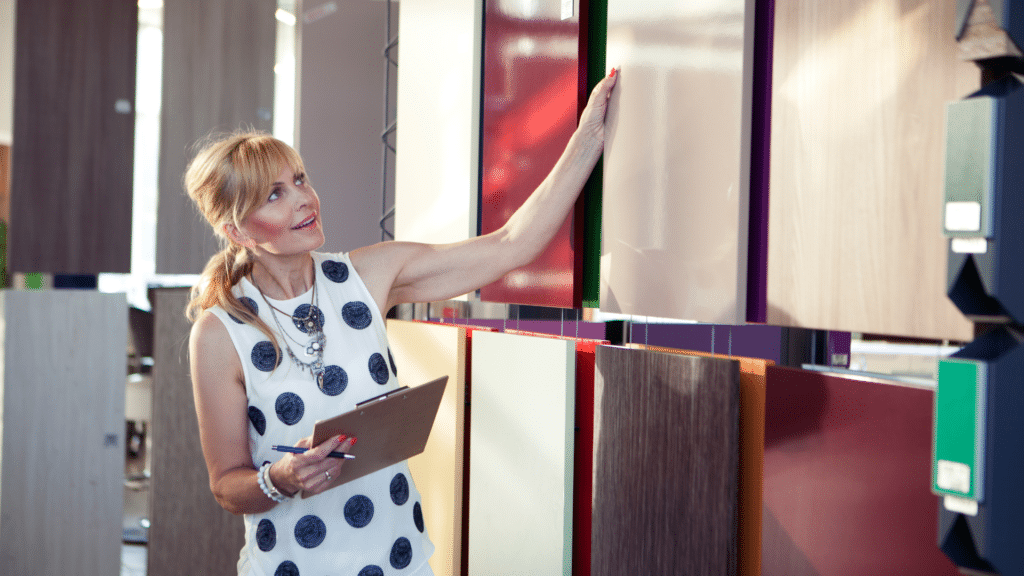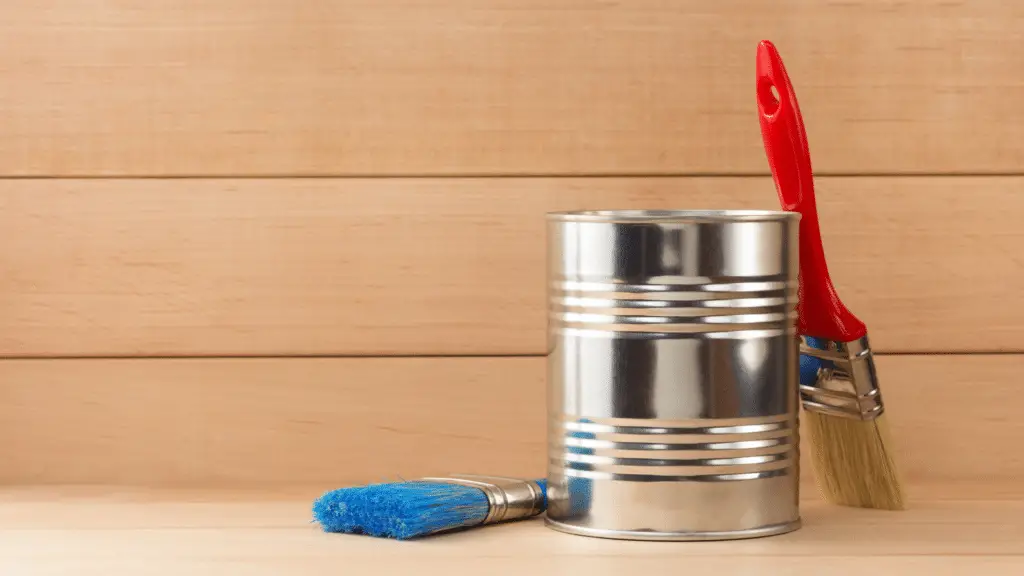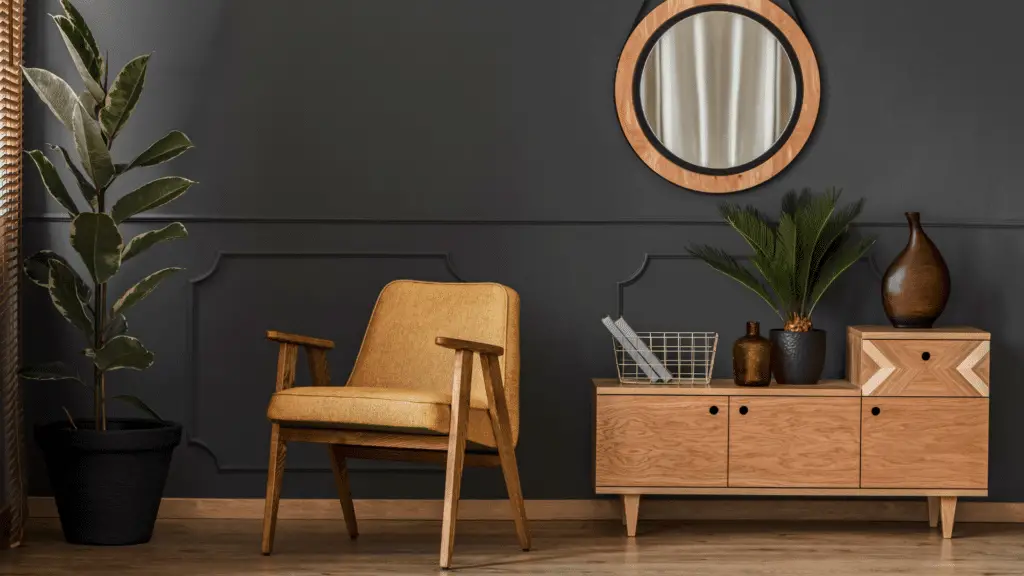Plywood is a versatile wood that can be used in many types of projects other than basic construction. Plywood is durable, tough, and inexpensive, but many people do not consider showcasing this product because they don’t know how to finish plywood to elevate its visual appeal. We have seven ways you can finish plywood to give it an elegant, stylish finish for use in any part of your home!
These 7 plywood finishing ideas can upscale the look of your plywood project.
- A smooth, ultra high-gloss finish.
- Staining the plywood.
- A modern matte finish.
- A modern painted finish.
- Retro paint finish.
- An Aged wood finish.
- A metal-like finish.
Plywood is often considered for construction projects rather than a product to deliver an upscale finish to surfaces in your home. Learning how to finish plywood to create a stunning, upscale final result will open new doors for using plywood in your projects!
Plywood Finishing Ideas
Plywood is a man-made timber product, and as such, different grades of plywood are created for various purposes.
The primary aspect of getting a good finish on your plywood project is to choose the suitable plywood. Getting this choice right will affect the final finish on the plywood and the ultimate success of the upscale look you are going for.

There are more than 20 different types of plywood, including softwood plywood, hardwood, marine, and even flexible plywood.
All these different types of plywood have different ply’s, relating to the thickness of each board. The main options are 3-ply, 5-ply, 7-ply, 9-ply, and 13-ply.
Within each type, there are also different plywood grades, usually grades A through D, with grade D being the lowest grade and grade A being the top grade.
We will not explore plywood types and grades here, but you need to be aware that the type of plywood and the grade will affect the quality of the final finish on the plywood. You should always source the best and most appropriate plywood for your project to get the best possible finish.
Let’s get onto the finishes you can put on plywood to transform it into an elegant and fashionable feature in your home.
1. Smooth Polished Look For Plywood
Plywood can be finished to a high gloss, polished look, which has excellent visual appeal, and waterproofs the plywood for use as tabletops or kitchen countertops.
The key to getting a smooth high gloss finish on plywood is to use good quality plywood, usually an A or B-grade plywood, and the preparation of the surface to make it ultra-smooth.
Selecting plywood that has a prominent natural woodgrain surface will give the final product a rich, natural wood glossy finish.
You will need the following items to give your plywood a high-gloss professional finish.
- 80-grit sandpaper
- 120-grit sandpaper
- 220-grit sandpaper
- 320-grit sandpaper
- Woodgrain filler
- Wipe-On Polyurethane
- Soft cloths
Sand the surface of the plywood down with 80-grit sandpaper. If you use a higher grade of plywood, start with the 120-grit sandpaper since the surface of better grade plywood will be smoother.
The sanding work on the plywood can be done by hand, but using an orbital sander will help to speed up the process. Always sand with the wood grain to avoid any cross-grain scratches that will show through the finish.
Once the initial sanding is done, dust the plywood off and then sand the surface with 120-grit sandpaper. The purpose here is to try and get the plywood surface as smooth as possible.

Plywood often has surface imperfections and hollows in the grain. We need to smooth these out to get the plywood surface very smooth. We use the wood grain filler to fill in these minor imperfections. A clear wood grain filler such as Aqua Coat Wood Grain Filler is ideal for the job.
Apply the wood grain filler on the surface of the plywood using a scraper to press it into the imperfections in the wood. Allow the wood grain filler ample time to dry and then sand the entire surface of the plywood with 220-grit sandpaper.
Wipe-on polyurethane such as Minwax Wipe-On Poly Clear Gloss gives a clean, glossy finish without drip or paintbrush marks. Wipe-on polyurethane is applied using a clean, lint-free cloth which will improve the high gloss finish.
Apply the wipe-on poly with a cloth as directed. Give the first coat time to dry completely, then lightly sand the surface with 220-grit sandpaper. Clean off the plywood sanding dust with a damp cloth and apply a second coat of the wipe-on poly.
Once the second coat has dried completely, give the surface a very light sand with 320-grit by hand to produce a shiny, smooth finish. Give the plywood a final wipe down with a clean cloth, and the job is complete!
2. Staining Plywood For A Classy Finish
Staining plywood, particularly plywood with a good wood grain pattern, allows you to enrich the color of the final project.
Plywood can be stained to mimic more expensive woods such as teak, oak or mahogany, to upscale the look of the plywood.

Select an appropriate stain for the look you want to achieve on the final product, such as General Finishes Red Mahogany stain.
Follow these steps to apply your chosen stain to the plywood.
- Sand the plywood. Use 220-grit sandpaper to lightly sand the surface of the plywood.
- Clean dust off the plywood. Vacuum the sanding dust off the plywood, or wipe it down with a damp cloth.
- Apply the stain. Apply the stain as recommended by the product manufacturer. Keep the coat as even as possible across the plywood surface.
- Wipe off excess stain. After the recommended time, wipe off any excess stain remaining on the surface of the wood. This is important to eliminate tacky spots on the surface.
- Give the stain time to dry. Allow ample time for the stain to soak into the wood and dry.
- Lightly sand the plywood with 220-grit sandpaper. This will prepare the plywood for your chosen finish.
If you have problems with the staining process, you should read our article on “How To Fix A Bad Wood Stain Job” for some tips and ideas.
Once the plywood has been stained, you can apply a satin polyurethane finish or a high-gloss polyurethane finish to seal the plywood and showcase the underlying wood.
3. Giving Plywood A Matte Finish
If a high gloss shine is not appropriate for the décor in your home, you may opt for a more subtle matte finish on the plywood but still keep wood showing through.
A matte finish on the plywood lends a warm, natural finish to the plywood. You can start by staining the plywood to your desired shade using the process we detailed earlier. Once the staining process is complete and you have done the final sanding of the surface, it is time to apply the finish.
Many matte-type finishes can achieve this effect on plywood, depending on what level of matte you are going for.
A satin polyurethane finish will give a semi-gloss finish. Still, if you are looking for a finish that is even more muted, a product such as Modern Masters Exterior Dead Flat Varnish would provide the perfect finish.
4. Painting Plywood For A Modern Look
Paint is a very forgiving finish to use on plywood compared to staining the wood and applying a clear finish. However, to get a clean, modern look, you need to prepare the plywood properly.
Sand the surface of the plywood with 120-grit sandpaper, and clean the sanding dust from the surface. Use a wood grain filler to smooth out all the imperfections in the plywood so that the paint will be flat and even when applied.

Once the wood grain filler has dried, sand the plywood down with the 220-grit sandpaper. The surface is now ready for the all-important primer.
Primer is crucial before painting the plywood. It seals the wood fibers so that they do not absorb all the paint when it is applied. Primers come in different colors, which can affect the final color of the paint you will apply.
For light-colored paint, use a light-colored primer, but start with a darker primer for darker paint.
- Apply the primer to the plywood. Apply the primer in an even coat on the plywood, using a roller of a paintbrush.
- Allow the primer to dry. The primer should be given sufficient time to dry completely, usually 24-hours, before applying the paint.
- Lightly sand the primed surface. Lightly sand the primer with 220-grit sandpaper. This is a light sanding to only smooth out any rough spots on the surface, not to remove the primer, so sanding by hand is preferable.
- Dust off the plywood. Make sure the plywood is clean and dust-free before applying the paint.
- Paint the plywood. Apply your chosen paint type and color to the plywood. The method of paint application will depend on the desired finish.
- Allow the first coat of paint time to dry. This is crucial; otherwise, the second coat of paint will bubble and not adhere to the first coat.
- Apply additional coats of paint. Depending on the paint and the desired finish, a second and third coat of paint may be required.
The best paint on plywood to achieve an ultra-smooth modern finish is acrylic paints and enamel paints.
5. Painting Plywood For A Retro Finish
A retro, used look can add some old-world charm to various plywood pieces or surfaces in your home. This result is best achieved by using a whitewashing effect on the plywood.
You can apply the retro whitewash finish to plywood using water-based paint or solvent-based paints. Light pastel colors such as white, pale blue, and yellow make ideal colors for this technique.
Prepare your plywood by sanding it smooth with first 120-grit sandpaper and then 220-grit sandpaper. Wipe the plywood down to get rid of the dust, and you are ready to start whitewashing.
- Dilute your paint 50/50. For water-based paint, dilute with water, and for solvent-based paint, dilute the paint with thinners.
- Mix the paint thoroughly. Make sure the paint is well-mixed with the diluting agent.
- Apply the paint to the plywood with a brush. Apply an even coat of whitewash mix paint on the plywood.
- Give the paint a few minutes to dry a little. Allow the paint to soak in for 10 or 15-minutes.
- Wipe excess paint off the plywood. Use a lean cloth to wipe excess paint off the plywood surface. This will thin out the coat of paint and allow the wood grain to show through.
- Allow the paint to dry completely. Give this coat of paint enough time to dry completely before adding another coat.
A second coat of your whitewash paint is not always necessary, but if you feel the first coat was a little thin, you can give the plywood a second coat to improve the whitewash effect.
To preserve the final finish, you can give the whitewashed plywood a light sand with a 220-grit finish with a clear lacquer coat to seal it.
6. Adding An Aged Finish To Plywood
This technique will age your plywood to give it the look of an old weathered barn door, or the look of a piece of driftwood washed up on the beach.

This method is very similar to whitewashing, but we add an additional step by adding some texture to the plywood surface.
You will need a whitewash mix as we used previously, but white acrylic paint is better for this process, diluted 1:1 with water. You will need the list of supplies below for this finish.
- 180-grit sandpaper.
- Medium brown wood stain or a grey stain for a driftwood look.
- Your whitewash mix.
- A drill with a wire brush attachment.
- A matte finish polyurethane
The method for this finish is reasonably straightforward.
- Abrade the plywood surface. Run the drill-powered wire brush over the surface of the plywood, following the grain of the wood. This gives the surface texture.
- Sand the surface with 180-grit sandpaper. Use the sandpaper wrapped around a block of wood and lightly sand the surface to remove loose pieces from the wood.
- Dust the surface off. Clean any dust and debris from the plywood surface.
- Apply the wood stain. Use a paintbrush to apply the stain, and wipe off excess stain with a lint-free cloth.
- Allow the wood to dry, then sand. Let the stain dry overnight, and then lightly sand with 180-grit sandpaper and dust the plywood off.
- Apply the whitewash mix. Paint the whitewash mix on the plywood with a paintbrush.
- Immediately wipe the whitewash off. Using a clean, lint-free rag, rub the whitewash off, following the grain of the wood. This leaves hints of white in all the hollow surfaces in the wood.
- Allow the whitewash to dry. Let the whitewash dry completely.
- Apply the polyurethane. Use a paintbrush and apply the matte finish polyurethane according to the product instructions. This will seal the wood and protect the finish.
This finish will provide a rustic, antique look to your plywood which may be desirable for your décor.
7. Give Your Plywood A Steel Finish
Another popular way to finish plywood is to make it look like steel. Plywood can be finished to look like black steel or old steel.
From an upscale perspective, the black steel finish adds a level of elegance to the plywood rather than the rusted old steel look.
To get the black steel look, first prepare the plywood by sanding it with 220-grit sandpaper. Clean off the plywood surface and apply a single coat of sanding sealer and allow it to dry. Knock off the spots with another light sanding with the 220-grit sandpaper.
Use a black wood putty, such as Minwax Ebony Wood Putty, to cover the entire surface of the wood in a thin layer. Use a putty knife to apply it to the surface and scrape off the excess.
For the next phase, you are going to need some genuine India ink. Art stores are the most likely places that will stock this ink. Genuine India ink is not water-based ink, so ensure you get the non-water-based version.
Use a cloth to rub the India ink into the wood and the wood putty. The ink will stain the surface black, giving a mottled look between the wood and the putty, giving the appearance of black, hammer-forged steel.
You need to take precautions with the India ink, as it will permanently stain anything it comes into contact with. Cover your workbench, wear old clothes and wear gloves to protect your hands.
Conclusion
Plywood is a surprisingly versatile material that can be transformed to look elegant, modern, retro, or even look nothing like wood at all.
The plywood surface accepts many types of finishes that can change its appearance. The primary key to achieving a professional, upscale finish is to prepare the plywood correctly.
Next time you build a project using plywood, experiment a little with the finishes. You will be pleasantly surprised how you can improve the final look of your project with this cheap material!
References

